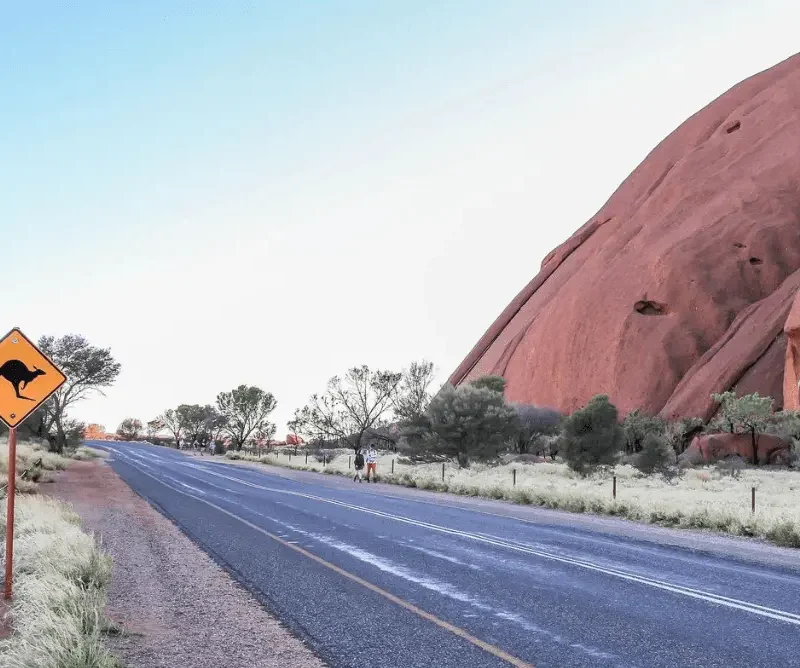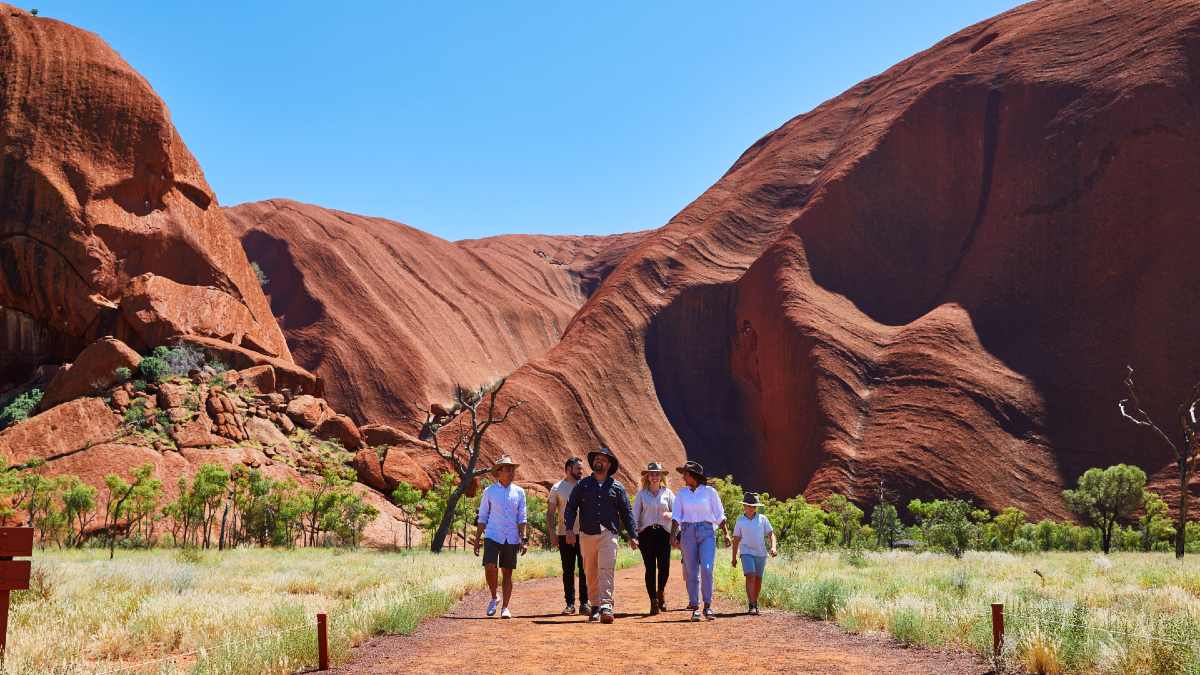
Uluru, also known as Ayers Rock, is more than just a giant sandstone monolith rising from the Australian Outback. It’s a sacred site steeped in Aboriginal history and spirituality, a geological wonder that changes color with the shifting sun, and an unforgettable experience that captivates travelers from around the globe. This comprehensive guide will provide you with everything you need to plan your perfect Uluru adventure, from understanding its rich past to navigating its unique environment.
A History Carved in Stone:
Uluru’s story stretches back hundreds of millions of years, far beyond recorded history. Its formation began during the Precambrian period, as sediments accumulated at the bottom of an ancient inland sea. Over time, these sediments were compressed and uplifted, forming the hard arkose sandstone that we see today.
Related Articles about Uluru: A Traveler’s Guide to the Red Heart of Australia:
- Conquering the Iconic: Your Comprehensive Guide to Visiting Mount Fuji
- Nairobi’s Finest: A Guide to the Top Hotels and Unforgettable Experiences in the Green City in the Sun
- Vietnam: A Tapestry of History, Culture, and Adventure
- Milan: A Symphony of Style, History, and Culinary Delights
- Seoul: A Metropolis Where Ancient Echoes Meet Futuristic Dreams
However, Uluru’s true history lies in its deep connection to the Anangu people, the traditional custodians of the land. For tens of thousands of years, they have lived in the region, their culture and stories intricately interwoven with the landscape. Uluru is central to their beliefs, a physical manifestation of the Tjukurpa (Dreaming), a complex system of creation stories, laws, and cultural practices.
The rock’s many caves and crevices hold ancient rock art, depicting stories of ancestral beings and their journeys across the land. These paintings, along with the rock’s physical features, serve as a living record of the Anangu’s connection to Uluru and the surrounding landscape.
European exploration began in the late 19th century, with surveyor William Gosse being the first European to record its existence in 1873. He named it Ayers Rock after Sir Henry Ayers, the Chief Secretary of South Australia at the time.
For many years, Uluru was primarily viewed as a tourist attraction, with climbing being a common activity. However, the Anangu people have always considered climbing Uluru to be disrespectful, as it is a sacred site. After a long campaign by the Anangu, the climb was officially closed in October 2019, marking a significant step towards recognizing and respecting their cultural heritage.
Today, Uluru is managed jointly by the Anangu people and Parks Australia, ensuring that its cultural and natural significance is protected for future generations.
Main Attractions: Beyond the Rock:
While Uluru itself is the star of the show, the surrounding area offers a diverse range of attractions:
- Uluru-Kata Tjuta National Park: This UNESCO World Heritage Site encompasses not only Uluru but also Kata Tjuta (The Olgas), a group of 36 dome-shaped rock formations located about 50 kilometers west of Uluru.
- Kata Tjuta (The Olgas): Explore the majestic Kata Tjuta through various walking trails, including the Valley of the Winds and the Olga Gorge Walk. These hikes offer stunning views and a chance to immerse yourself in the rugged beauty of the landscape.
- Cultural Centre: Learn about the Anangu culture, history, and Tjukurpa at the Uluru-Kata Tjuta Cultural Centre. Participate in workshops, browse Aboriginal art and crafts, and gain a deeper understanding of the spiritual significance of the region.
- Sunrise and Sunset Viewing Areas: Witness the breathtaking spectacle of Uluru changing colors as the sun rises and sets. Designated viewing areas offer unobstructed views and allow you to capture the magical moment.
- Mala Walk: This guided walk along the base of Uluru, led by park rangers, provides insights into the Anangu culture, the geology of the rock, and the native flora and fauna.
- Kuniya Walk: This shorter walk leads to the Mutitjulu Waterhole, a significant site in the Tjukurpa stories.
- Field of Light: As dusk settles, the Field of Light, an art installation by Bruce Munro, illuminates the desert with over 50,000 solar-powered lights, creating a mesmerizing display.
- Sounds of Silence Dinner: Enjoy a unique dining experience under the stars, complete with a didgeridoo performance and a guided tour of the Southern Hemisphere constellations.
- Maruku Arts Gallery: Discover and purchase authentic Aboriginal art and crafts directly from local artists at Maruku Arts Gallery.
Travel Tips for a Seamless Uluru Experience:
- Respect the Culture: Remember that Uluru is a sacred site. Be mindful of the Anangu culture and traditions. Do not climb Uluru (the climb is permanently closed). Ask permission before taking photos of Aboriginal people.
- Plan Ahead: Book your accommodation, tours, and activities in advance, especially during peak season (May to September).
- Stay Hydrated: The desert climate can be harsh. Drink plenty of water throughout the day to avoid dehydration.
- Protect Yourself from the Sun: Wear sunscreen, a hat, and sunglasses to protect yourself from the intense sun.
- Dress Appropriately: Wear lightweight, breathable clothing. Long sleeves and pants can provide extra protection from the sun and insects.
- Be Aware of the Environment: The desert environment can be challenging. Be aware of the risks of heatstroke, dehydration, and sunburn. Stay on marked trails and follow safety guidelines.
- Learn About the Tjukurpa: Take the time to learn about the Anangu culture and the Tjukurpa. This will enhance your understanding and appreciation of Uluru and the surrounding landscape.
- Consider a Guided Tour: Guided tours can provide valuable insights into the history, culture, and geology of the region.
- Pack Appropriately: Pack comfortable walking shoes, insect repellent, a reusable water bottle, and a camera to capture the stunning scenery.
- Be Prepared for the Weather: The weather in Uluru can be unpredictable. Be prepared for hot days and cold nights.
Best Time to Visit:
The best time to visit Uluru is during the shoulder seasons:
- April-May (Autumn): Mild temperatures, fewer crowds, and pleasant conditions for hiking and outdoor activities.
- September-October (Spring): Similar to autumn, with comfortable temperatures and blooming wildflowers adding to the scenic beauty.
The summer months (December-February) are extremely hot, with temperatures often exceeding 40°C (104°F). The winter months (June-August) can be cold, especially at night.
Nearby Hotels: Your Oasis in the Outback:
Yulara, a resort town located a short distance from Uluru, offers a range of accommodation options to suit different budgets:
- Sails in the Desert: A luxury hotel with spacious rooms, a swimming pool, and multiple dining options.
- Desert Gardens Hotel: A more affordable option with comfortable rooms and a garden setting.
- Emu Walk Apartments: Self-contained apartments with kitchen facilities, ideal for families or longer stays.
- Outback Pioneer Hotel & Lodge: A budget-friendly option with a range of accommodation choices, including hotel rooms and dormitory-style rooms.
- Longitude 131°: A luxurious glamping experience offering unparalleled views of Uluru from private tents. (Premium)
Local Food: A Taste of the Outback:
While Yulara offers a variety of restaurants serving international cuisine, be sure to try some local specialties:
- Bush Tucker: Sample native Australian ingredients like kangaroo, emu, crocodile, and bush tomatoes.
- Damper: A traditional Australian bread cooked in a campfire.
- Barramundi: A popular Australian fish, often grilled or pan-fried.
- Quandong Pie: A dessert made with the native quandong fruit, which has a tart and slightly sweet flavor.
Transportation Options: Getting Around Uluru:
- Flights: Ayers Rock Airport (AYQ) is the main airport serving Uluru. Direct flights are available from major Australian cities.
- Car Rental: Renting a car is a convenient way to explore Uluru-Kata Tjuta National Park and the surrounding area.
- Shuttle Buses: Shuttle buses operate between the airport, Yulara, and Uluru-Kata Tjuta National Park.
- Tour Buses: Many tour operators offer guided tours that include transportation.
- Camel Tours: Experience the Outback in a unique way with a camel tour.
In Conclusion:
A trip to Uluru is a journey into the heart of Australia, a land of ancient culture, breathtaking landscapes, and unforgettable experiences. By respecting the Anangu culture, planning ahead, and being mindful of the environment, you can create a truly meaningful and memorable adventure. Uluru is more than just a rock; it’s a living testament to the power of nature and the enduring spirit of the Aboriginal people. So, pack your bags, prepare to be amazed, and embark on an adventure to the Red Heart of Australia. You won’t be disappointed.








